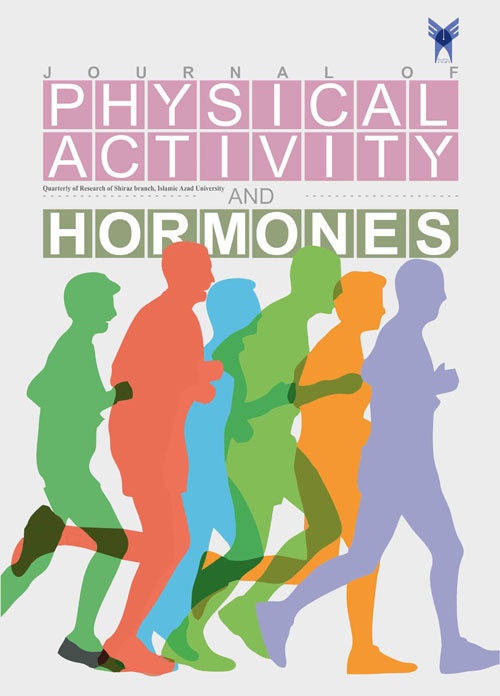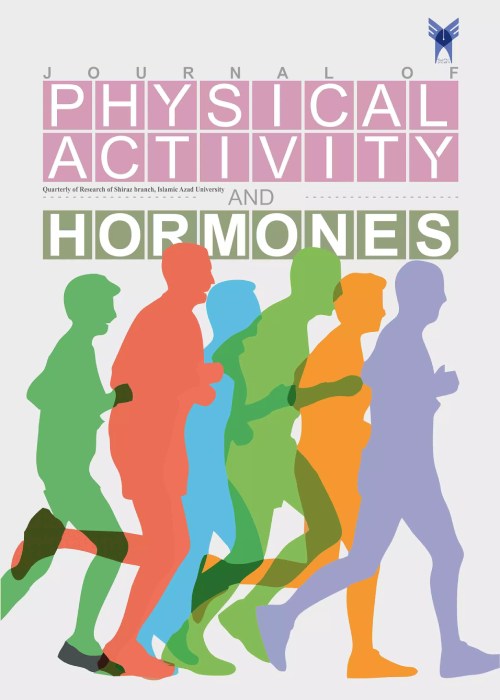فهرست مطالب

Journal of Physical Activity and Hormones
Volume:4 Issue: 3, Summer 2020
- تاریخ انتشار: 1400/11/09
- تعداد عناوین: 5
-
Pages 1-16Introduction
The aim of present study was to investigate the combined effects of aerobic exercises and l-arginine ingestion on total antioxidant capacity (TAC) and C-reactive protein (CRP) in diabetic male rats.
Material & MethodsAnalysis method 24 male rats (age :12 weeks, weight range of 260-360 g) were put randomly into 4 groups of healthy control (n=6), L-arginine supplement consumption group (n=6), aerobic exercise group (n=6) and L-arginine supplement consumption group with aerobic exercise group (n=6).All of these groups which became diabetic by injection of STZ except the healthy control group were under the study. The aerobic exercise group and L-arginine consumption group and aerobic exercise started walking or running on the treadmill with 10 m/min and slope of 0° for 5 sessions of 15 minutes in a week. After each day, 1 m/min and 5 minutes were added to their exercise and at the end of the seventh day the speed reached to 16 m/min and the time became 45 minutes.
ResultsThe present results showed that L-arginine supplement consumption made a significant difference between TAC-CRP indicators in supplement and placebo groups. L-arginine supplement consumption made a significant reduction in TAC antioxidant indicator and resulted in CRP increase. TAC antioxidant indicator has an increasing effect on the improvement of total antioxidant capacity of diabetic rats by doing sport exercises but the sport exercises reduce CRP level. Aerobic exercises along with L-arginine supplement consumption didn’t change TAC antioxidant indicator of mature rats a lot and are the same in both exercise and without exercise levels but had a significant difference in CRP levels between aerobic exercise-supplement and placebo groups. Exercise reduced significantly on CRP indicator of mature diabetic rats in supplement consumption situation than placebo situation. On the other hand, there was a significant difference between the mean of CRP antioxidant indicator between supplement consumption without exercise and placebo without exercise.
ConclusionsL-arginine supplement resulted in the significant increase of CRP in diabetic mature rats than placebo.
-
Pages 17-31
Cortisol is a glucocorticoid, synthesized in response to the action of adrenocorticotropic releasing hormone (ACTH) on adrenal glands (AG) and released from zona fasciculata. Increased cortisol is associated with psychological and physical stress. Several strategies have been used in the past to overcome stress in an athletic and healthy population. Among these strategies, exercise has been shown to beneficial for the management of stress. However, it is unknown if these benefits are due to the direct effect of exercise on cortisol levels. In this brief review, we have outlined the benefits of exercise and how exercise in previous literature has shown to affect cortisol levels in two ways. First, by directly activating the hypothalamus-pituitary axis (HPA) and second, by releasing ACTH which acts on AG and stimulates the release of cortisol. This mini-review will discuss the effects of type of exercise (aerobic and resistance) on cortisol synthesis and release, metabolism, and clearance.
Keywords: Cortisol, Exercise, Stress, glucocorticoid, Hormone -
Pages 33-47Introduction
The aim of the present study was to determine the effect of 8-week resistance training on irisin, preptin and insulin resistance in obese women.
Material & MethodsIn this quasi-experimental study, 20 obese women aged 30-45 years were selected and randomly divided into two groups of resistance training (n = 10) and control (n = 10). The method of the study was that 24 hours before the beginning of the exercises, the individual characteristics of the subjects and the research variables (insulin resistance, Glucagon-like peptide-1(GLP-1), Dipeptidyl peptidase-4 (DPP-4)) were measured in the pre-test. Subsequently, the subjects in the resistance training group performed their training program, which was initially 1RM using the Berziki formula. Subjects then began their workouts for 8 weeks, three sessions per week at 40% intensity and 5 repetitions in the first week, and gradually increased intensity to reach 90% at week 8 with 5 repetitions. Paired-sample t-test, two-way ANOVA and Bonferroni post-hoc analysis were used for data analysis.
ResultsThe results showed that resistance training had an effect on the levels of peptin, irisin and insulin resistance in obese women. Resistance training, time, and the interactive effect of exercises and time have an impact on the levels of preptin, irisin, and insulin resistance in obese women( p=0.01). There was also a significant difference between pre-test and post-test on one hand and exercises and no practice on the other(p=0.01)
ConclusionsAccording to the findings of this study, it can be suggested that resistance training can be a suitable solution to weight control and obesity and prevent their complications.
Keywords: Resistance training, Preptin, Irisin, Insulin resistance, obese women -
Pages 49-60Introduction
Ghrelin and leptin hormones are engaged in energy regulation. The purpose of this study was to investigate the effect of physical exercise alone or combined with an omega-3 supplement on leptin and ghrelin secretion in healthy young women.
Material & MethodsIn this experimental study, sixty non-athlete women (23.38±2.45) were randomly divided into control, exercise, supplement, and exercise-supplement groups. The exercise program consisted of 90-minutes basketball training (with 50-55% maximum heart rate (HRmax) increased gradually to 65-75% HRmax in two last weeks) for 12 weeks (3 days/week). The supplement was a daily intake of an omega 3 soft gel containing 1000 mg Omega 3. A blood sample obtained before and after the interventions assess serum levels of Ghrelin and Leptin hormones by ELISA. The one-way ANOVA and dependent T-test were used to analyze the data. P≤0.05 is considered statically significant.
ResultsThe serum level of leptin and ghrelin hormones significantly reduced and increased, respectively, in post- compared to the pre-experimental period in supplement, exercise, and exercise + supplement groups (p<0.05). Leptin hormone was reduced while ghrelin hormone increased significantly in supplement, exercise, and exercise + supplement groups (p<0.05) compared to the control group in the post-experimental period. There was also a remarkable difference between the supplement group and the exercise +supplement group (p=0.05).
ConclusionOur results suggested that physical activity or omega 3 consumption alone leads to an increase in serum ghrelin hormone and a decrease in serum leptin hormone in young non-athlete women. It seems that a combination of both has synergic effects.
Keywords: Leptin, Ghrelin, non-athlete women, metabolic system, body weight -
Pages 61-75Introduction
Prenatal seizures cause the production of free radicals in fetal nervous system and selective neuronal death of hippocampus. The purpose of this study is to evaluate the effect of swimming exercise (EX) and hesperidin administration (HES) as a potent antioxidant on hippocampal cell damage in rats following pentylenetetrazol (PTZ) induced prenatal seizures.
Materials & methodIn this experimental study, infants from 20 females pregnant Wistar rats were randomly put in 5 groups of control, PTZ+NS, PTZ+HES, PTZ+EX, PTZ+HES+EX. From the 14th day of pregnancy, animals were exposed to repeated PTZ injection (50mg/kg, intraperitoneal) for 5 consecutive days. From the first day of pregnancy to the term delivery, swimming exercise training with moderate intensity and 3 times a week and daily hesperidin gavage for 3 weeks was done. Finally, the hippocampal cell density was evaluated in different hippocampus areas of male infants at postnatal day 30.
ResultsThe increase of cell damage and decrease of cellular density in different regions of hippocampus was seen in PTZ+NS group than the control group (p<0.05). Meanwhile, the increase of hippocampal cellular density and decrease of mortality of pyramidal neurons was also observed in PTZ+HES+EX group compared to PTZ+NS group (p<0.05).
ConclusionsThe interaction of swimming exercise training and hesperidin have neuroprotective effects in rats’ prenatal seizure models.
Keywords: pregnancy, Swimming, Hesperidin, Seizure, Hippocampus


